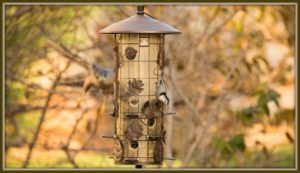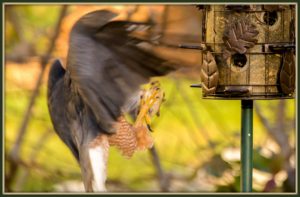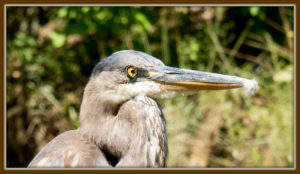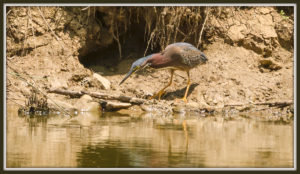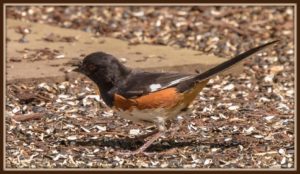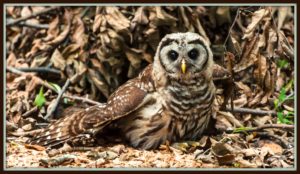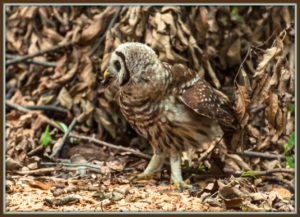Monday Ornithological Musings
Double-click on any image to view it full size. Click the back-button to return to your place on this page.
Greetings!
I have been thinking recently about just how much wildlife we are fortunate enough to see within our own community. Lansdowne Woods occupies some 44 acres of land. Much of this, not surprisingly, is taken up by the eight residential buildings, the community clubhouse, roadways, sidewalks, parking lots, and formal landscaping. But we also have some virtually untouched woodland and two ponds, one very small and one somewhat larger. That habitat provides homes, or at least visiting places, for a wide variety of birds and other creatures. This week’s pictures feature some of the less frequently seen birds. A such, some of them are “record shots” rather than particularly outstanding images, but I hope they are of interest.
Perhaps appropriately, picture #1 was taken right at the main entrance to the property, with the bird sitting on the boundary fence.
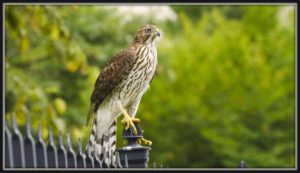
It appears to be a juvenile Cooper’s Hawk, but since neither the back of its head nor the end of its tail can be clearly seen, it may be a (juvenile) Sharp-shinned Hawk. The next two pictures were the result much more of luck than judgment. As I was looking through my viewfinder taking #2, of a White-breasted Nuthatch on a feeder, I became aware of something strange happening, and without realizing what was happening, took #3.
In #3 it is quite clear that a hawk has snatched a Goldfinch from the far side of the feeder – the victim can be seen in the talons of the hawk – and is executing a quick 180 degree turn before flying away with its prey. Subsequent inspection of #2 reveals the hawk swooping-in just to the left of the feeder, but out of focus because of the limited depth of field of the picture. Once again it is a bit of a dilemma trying to decide if it is a Cooper’s or a Sharp-shinned, but the horizontal barring on its breast shows it is an adult rather than a juvenile.
The larger of our two ponds, until quite recently, was not visited very much by humans. It was however, visited by the occasional Great Blue Heron (#4) or Green Heron (#5).
The great Blue Heron picture shows very clearly the edge of the transparent nictitating membrane crossing the middle of its eye. This “third eyelid” is found in birds, reptiles, sharks and some mammals, and serves to protect the eye under certain risky circumstances, such as snatching at food, or to spread moisture across the eye, while still allowing some vision. A couple of years ago, this pond was drained at the start of the conversion of the former sales office into additional residential units, and the plan was to eliminate it entirely. Fortunately (to my way of thinking anyway), the plan evolved and after some re-contouring of its banks, the pond was allowed to refill. It is slowly regaining much of its wildlife, and within the few weeks I observed this Spotted Sandpiper there (picture #6).
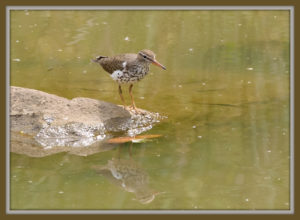
This was the first time I had seen one of these birds on the property, and I think it bodes well for the future of the pond. I photographed the Great Egret shown in #7 last week in the vicinity of the pond, but I have never seen one on the ground (or in the water) there or anywhere else on the property itself, but I have seen them on the banks of the pond on the adjacent golf course.
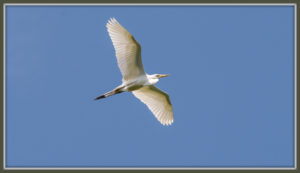
Our wooded areas are under constant pressure as some of the trees succumb to old age and the effects of developing the rest of the property. While they last, they provide shelter for many species. Picture #8 shows (in a very poor quality image), what I believe is an Indigo Bunting.
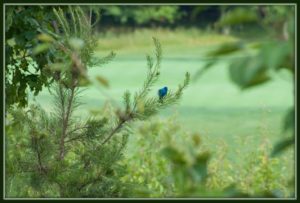
This was the only time I have seen one of these. Fallen leaves and other debris provide shelter for various insects and other food for species such as the Eastern Towhees shown in #9 (male) and #10 (female).
These almost-Robin-sized members of the sparrow family can sometimes be glimpsed amongst the leaves, which they turn over with their feet, but these two (which I suspect may be a nesting pair) ventured out far enough to offer a clear view. I close this week with two pictures of a juvenile Barred Owl I was fortunate enough to see in our woods one afternoon while there was still enough light to get reasonable pictures. I have featured a picture from this encounter with this particular owl perched on a tree branch in an earlier essay, but during the encounter (which lasted over 30 minutes) the owl swooped to the ground to trap under its wings (#11) and then grab with its beak (#12) what appears to be some kind of beetle.
Have a great week!
